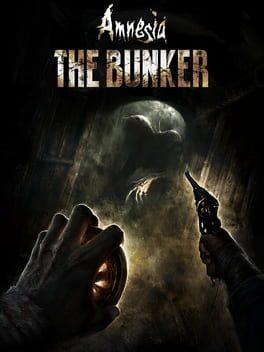If you’ve followed the Amnesia series, a title like “The Bunker” probably inspired a lot of confidence. It’s simple. It calls back to the elegance of The Dark Descent, it’s not a tie into some ham-fisted game-spanning metaphor. Sure enough, this plays more like Descent than Pigs or Rebirth, centering on the horror natural to total darkness rather than being artificially constructed by a narrative. The pace is hands-off, with the single objective of escaping the titular bunker being given at the start, and the rest is up to you. Discover how to escape, come up with solutions, avoid the monster. This loose format is meant to tie into the game’s selling point of allowing for open-ended approaches. The Dark Descent had you solving puzzles to unlock new areas, but in The Bunker you might find a door and decide to smash it, blast it, or unlock it. Some options may attract the monster, but hey, you gotta escape somehow.
…and that “how” is by smashing, blasting, or unlocking. I know I already said that, but as much as The Bunker wants to create an air of immersive choice, your options boil down to these three things for every door in the game. There are literally no puzzles at all, only doors. Each area has its own twists on how it limits those three options, but this isn’t Prey where you have about eighteen choices for every obstacle; you’re using bricks, grenades, or keys. The interaction with the monster is similarly shallow, working identically to any other basic stealth-game enemy since time began: you can put down distraction items or throw something to make a noise. It results in the monster having no unique personality or identity, and it doesn’t foster the type of creativity the game begs for with its loading screens, which tell players that any solution they can imagine will probably work. With that being insisted upon multiple times every session, I really tried to do unique things, like set up time-delayed distractions in different areas or use physics objects to circumvent obstacles, but you just can’t do that. It’s too simple. That’s not always a bad thing for a horror game, but if immersive interaction was what we were supposed to get in exchange for a tightly designed atmosphere and an interesting narrative, then all we’ve done is go backwards.
…and that “how” is by smashing, blasting, or unlocking. I know I already said that, but as much as The Bunker wants to create an air of immersive choice, your options boil down to these three things for every door in the game. There are literally no puzzles at all, only doors. Each area has its own twists on how it limits those three options, but this isn’t Prey where you have about eighteen choices for every obstacle; you’re using bricks, grenades, or keys. The interaction with the monster is similarly shallow, working identically to any other basic stealth-game enemy since time began: you can put down distraction items or throw something to make a noise. It results in the monster having no unique personality or identity, and it doesn’t foster the type of creativity the game begs for with its loading screens, which tell players that any solution they can imagine will probably work. With that being insisted upon multiple times every session, I really tried to do unique things, like set up time-delayed distractions in different areas or use physics objects to circumvent obstacles, but you just can’t do that. It’s too simple. That’s not always a bad thing for a horror game, but if immersive interaction was what we were supposed to get in exchange for a tightly designed atmosphere and an interesting narrative, then all we’ve done is go backwards.
